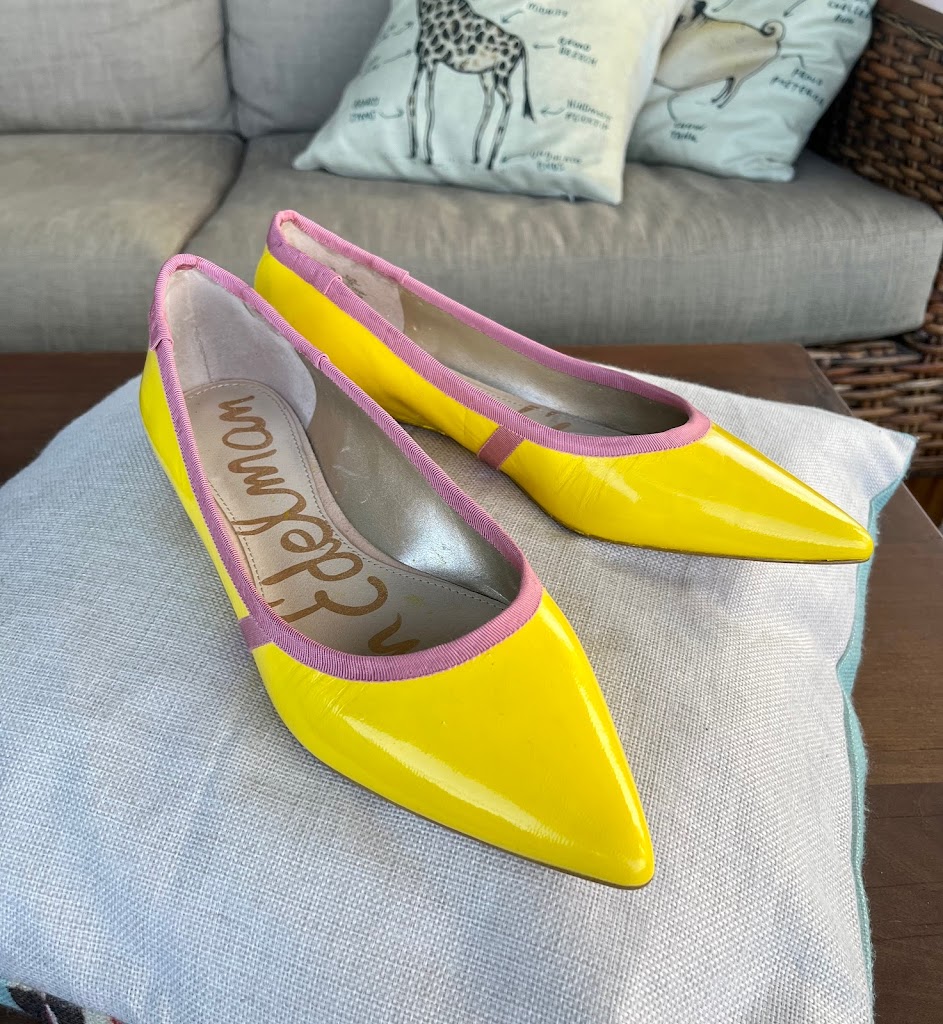
Last September, I was lucky enough to score a pair of American Duchess Kensington shoes on Poshmark. I’ve always liked the idea of using bright yellow as a neutral shoe color, and this pair seemed an opportunity to make myself a pair of myself a pair of bright yellow mid-century shoes. I didn’t want to begin with my prize, so I purchased a pair of flat white slippers, and made myself a pair of painted 1790s shoes as a trial run. Here is my tutorial for 1790s painted shoes, Part 1!

I’ve never worked with leather before- in any manner- so I did a lot of reading. Most costumers seem to favor paint, but a few use leather dye. Both approaches seemed reasonably reasonable, so I took myself off to the Tandy Leather store in Reno. Dithering over the racks of paints and dyes, I was approached by a fellow most GLORIOUSLY decked out in a leather apron painted in all sorts of swirls and swatches. We had a talk about the merits of dye vs paint and which would wear best – by which I mean I mentioned both options, and he asked if I’d worked with leather before, and on hearing me say “No, but -” stopped me at the “no” and told me in no uncertain terms that as a first timer, I would definitely be going home with the leather paints.
I came home to Chile with bottles of Angelus leather preparer, Angelus leather finisher and Angelus leather paint. I also came home with a second pair of shoes. I didn’t want to jump straight to my precious Kensingtons, so I went on ebay and bought an inexpensive pair of Sam Edelman leather flats to use as a test bunny for all my new bottles. With a little luck, my 1790s Green Blob gown would also end up with a lovely pop of yellow peeping out from below the hem.
Back home, I worked on the two pairs at once – testing each step on the flats, and then moving onto the Kensingtons. My hope is that my process – mistakes, corrections and the lot – may prove useful for anyone else thinking about a pair of custom colored historical shoes! On then, to the 1790s Painted Shoe Tutorial: Part I!
Step One: Prepping the Leather
The first order of business was to remove existing glaze and polish. It was a straightforward operation: I put some Angelus leather Preparer/Deglazer solution on a clean rag, and wiped carefully over the shoes. I wiped down all 4 shoes, and then I did it again, just to make certain I had caught all the folds and wrinkles.

The stuff works pretty much instantaneously – you can see and you can feel the difference between the polished and the deglazed shoe. In fact, so powerful is this stuff, that I left the rag sitting on the toe of one of the flat shoes for all of 10 seconds while I put the lid back on the bottle, and it stripped right through the glaze and the leather dye, leaving a large irregular mark that took several extra layers of paint to cover up.
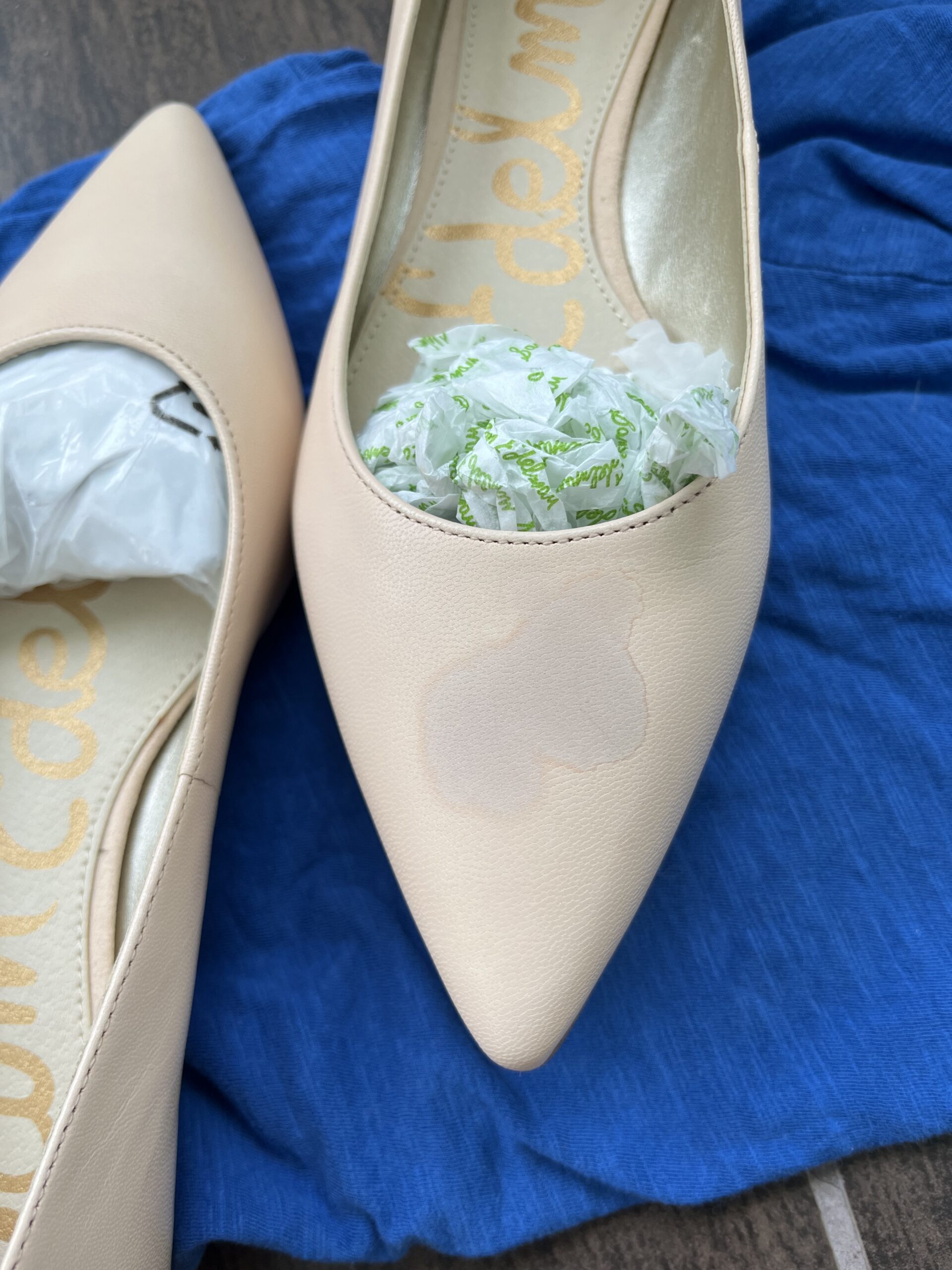
I found this accident quite reassuring. If I really screwed up with my paint job, I would clearly have no problem stripping my work and starting again.
A Caveat: Later, when I began painting the Kensingtons, I discovered that I had not removed all of the original glaze. The paint was skating over patches of leather like watercolor paint over a wax resist. With multiple coats of paint, I was eventually able to cover these areas, but it was an interesting lesson in how shoe polishes and glazes differ from brand to brand.

The Sam Edelman flats had stripped very easily, but the AD formula is more tenacious. When you do your pre-paint stripping with the Angelus Preparer/Deglazer, do your AD shoes again. And possibly a third or fourth time as well, just to be certain.

Step 2: Taping the Heels and Soles
I was thorough about this. I was VERY thorough about this – cutting and pressing many infinitesimal bits of painters tape onto the curves of the heels on the Kensington shoes, and I will say up front that this was probably the biggest mistake that I made in the whole exercise:
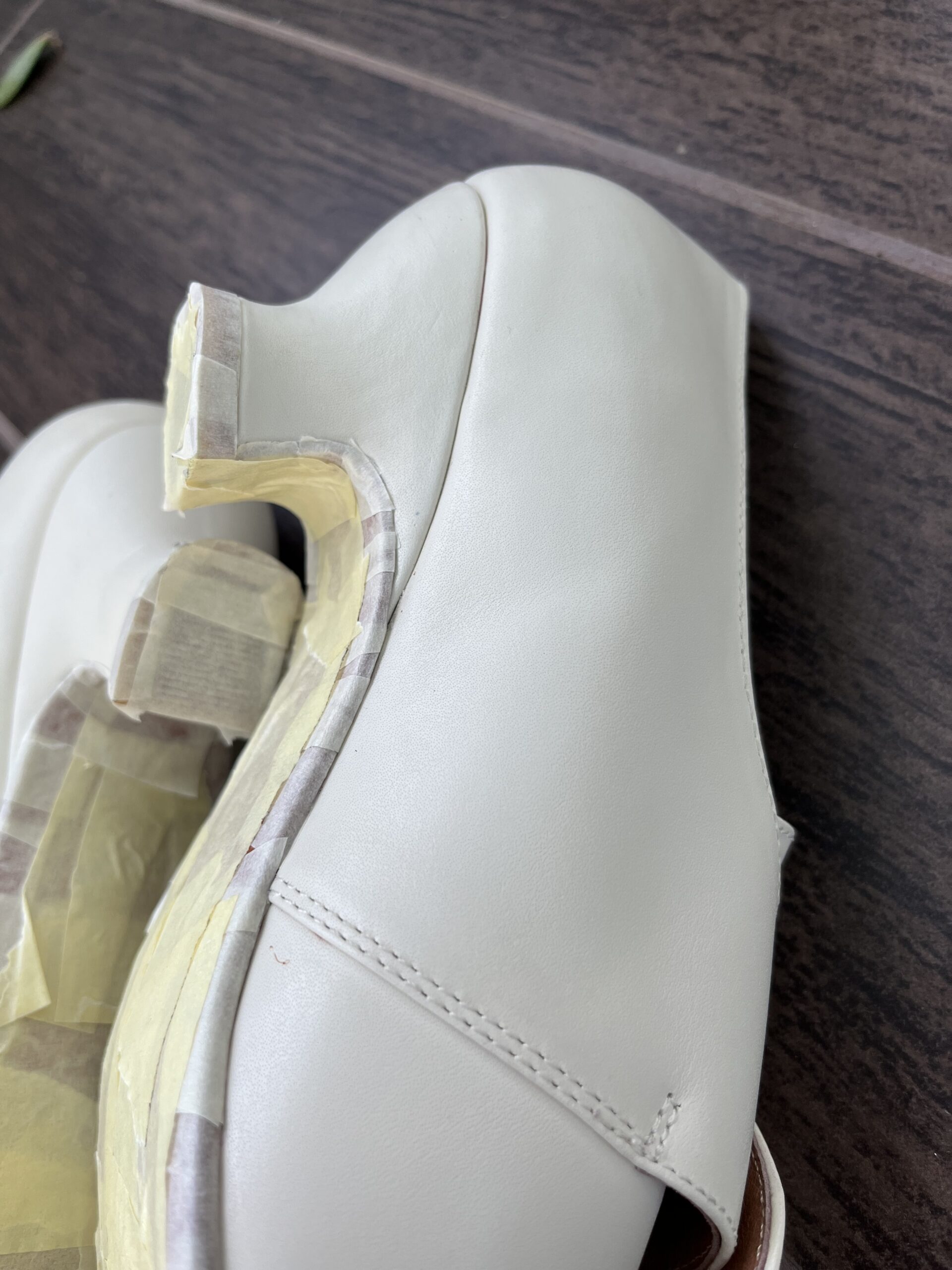
Angelus leather paint is an acrylic paint. This means that it doesn’t sink into the surface of the leather. It sits on it and makes a film on top of the shoe – and on the tape if I splashed paint over the edge of the heel. When I removed the tape at the end of the paint job, there were places where I ripped entire strips of paint away with it. The way some costumers ended up painting the edges of their shoe soles black at the end of the whole process started making a whole lot more sense.
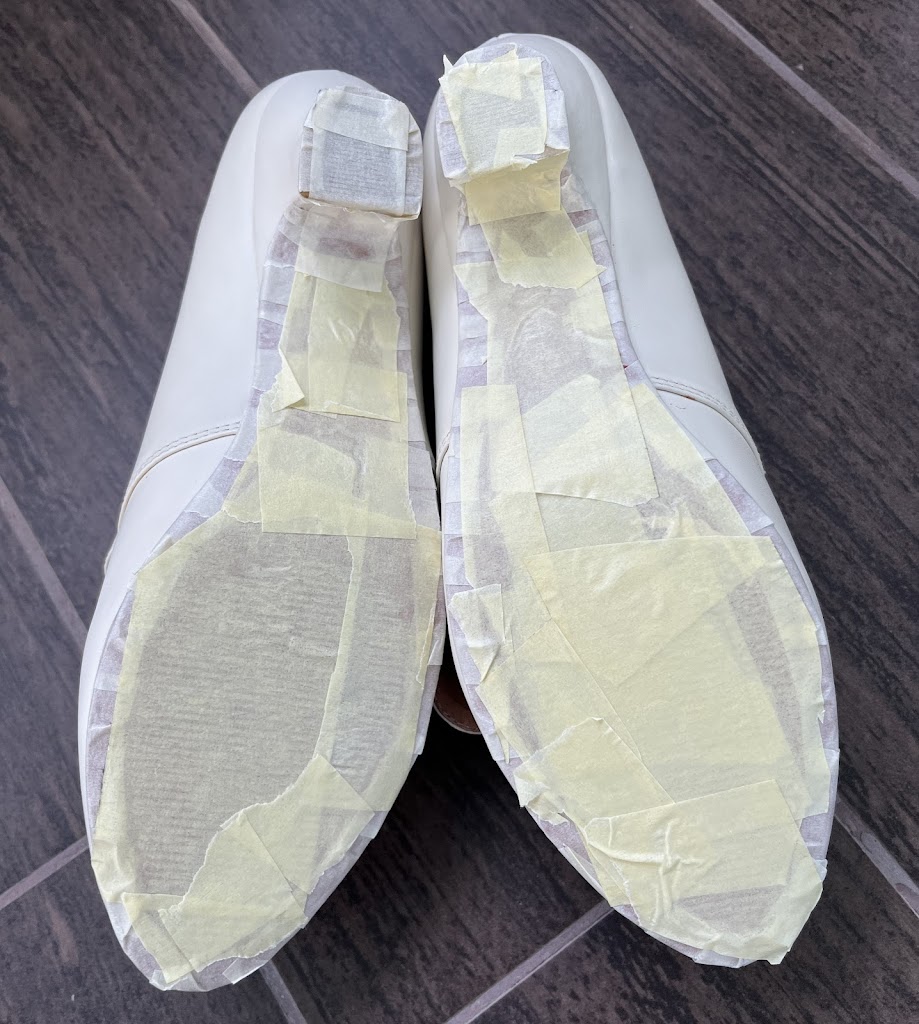
Step 3: Painting the Shoes
I didn’t want to use the yellow color straight out of the Angelus bottle. I wanted a softer, more lemon-y shade.

In a lidded plastic tub, I mixed yellow with white, and thinned it out with water. The tutorials had recommended quite a thin mix – and here, again, I overdid it, and mixed up a lovely thin glaze of color that painted on without streaking or lumping, but when I had reached 10 coats on the flat shoes, I realized I may have gone just a little off the rails, and I left the lid off of the paint tub to evaporate some of the water out.

Tips for Painting
Use thin coats. The paint doesn’t have to be translucently thin, but it does need to be thin enough to flow cleanly over the shoe without stippling or streaking. I did find that a smaller brush tended to result in less streaking than a large one.
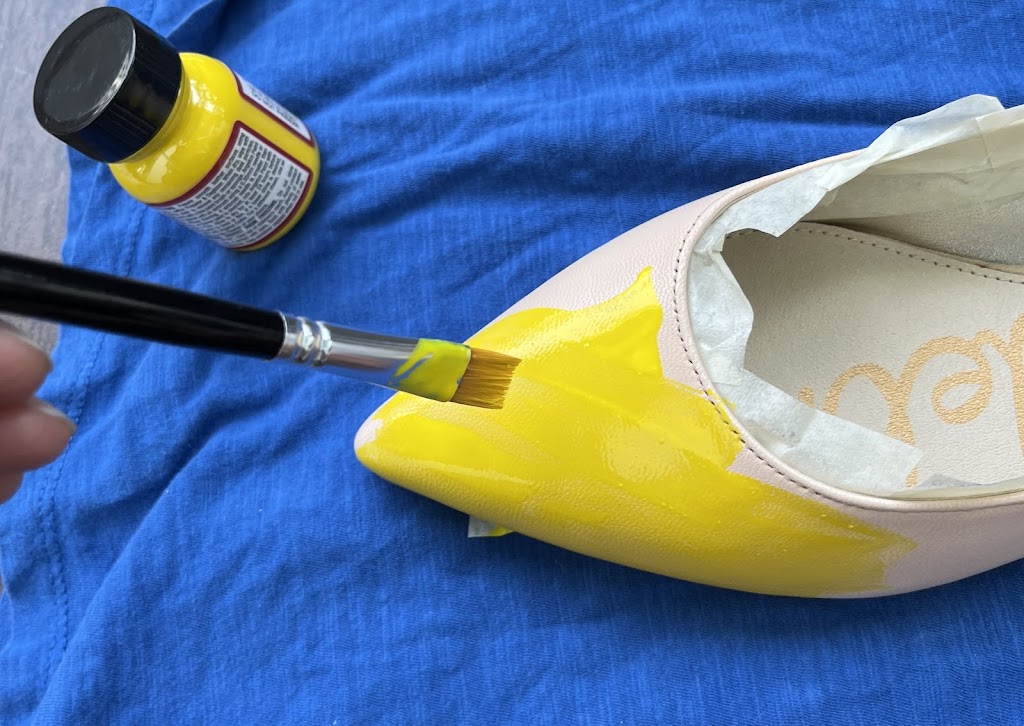
I found that the best results came from letting the paint dry completely between coats. It is quite humid where I live, and I found the best thing was to lay down a coat of paint, seal the lid on the plastic paint tub, and walk away and do something else for 15-30 minutes. Take your time, go gently, and build your color.
When you come back to the next coat, make sure to stir your paint before you apply the next one! The paint pigments have different densities, and if you don’t remix your color you’re liable to find you have lighter and darker patches across your shoe.
When you have built up the color to a strength that you like, stop, take a moment, and think “Holy HECK. If I scuff these shoes, I am never ever ever going to match this custom color. I should have used the paint as it came, straight out of the bottle.”

But it will be too late for regrets by then, so bury your feelings down deep and move on to –
Step 4: Removing the Painters Tape
As I wrote above, this was where I ran into another snag – removing the tape around the heel edges, I also removed strips of paint!

At this point I stopped stripping, and went around the entire edge of the heel with a craft knife, digging deep into the join between leather heel and shoe body. And then I removed the rest of the tape. Very carefully.

Fortunately, the stripped patches filled in quite easily. The texture is faintly blobby, but it is hidden in the under-curve of the shoe body, and anyone close enough to see that deserves all the satisfaction they deserve from it.
A bigger problem for me was all the paint that had gotten under the tape and onto the heel.

At this point I was thinking some pretty serious thoughts about all the time I’d spent taping the damn things. I tried chipping with a knife, but didn’t make much headway. I tried dabbing with the Preparer/Deglazer, but discovered that the dark color of the sole edges was coming off and leaving bleached spots! At this point I decided that I could either paint the heels entirely or leave them as they were, but as I
a) didn’t have any brown or black paint
and
b) figured I’d just end up splashing back up onto the shoe body if I tried, I decide to move on and let it go. If someone sees it – well, lying down with your nose in the grass to critique a paint splash on the underside of a shoe deserves SOME sort of win.

Step 5: Sealing the Shoes
Color applied and holes patched, it was time to seal and varnish the shoes. The procedure was pretty simple – pour a bit of Angelus satin shoe sealer into a bowl and apply it with a brush. Again, a smaller brush was more effective than a larger one, and again, I applied several coats, with resting time between each. In consideration of future difficulties matching a custom color, I had some idea that more coats would provide more protection against scuffs. (I have no idea how effective this will turn out to be. It will be an interesting experiment.)
Using the sealer is where I discovered my third and fourth mistakes.
I strongly suggest that when you seal your shoes, dry the sealer coats with the shoes sitting beneath an overturned plastic tub. Or else knock up your local high school chemistry department and ask to borrow their fume hood. Any dust that settles on your shoes will get stuck in that varnish. And if you’re not paying particular attention, you may not notice this until the second or third coat, and then that cute little grey curl of dust across the tip of your pretty yellow shoe?
It’s there FOREVER.

My other mistake was a GLARING one. In doing my pre-project research, I had seen that a small minority of people were choosing a matte varnish over the satin one, claiming that the satin was just too shiny. The Tandy leather man had voted for the satin, so I went that way as well, but HOLY HECK – on these shoes, that satin-coat finish was about as satiny as a brand new patent vinyl raincoat. Under a stage-light. You know that very twentieth-century ultra-high-gloss high-beam plastic leather finish?

Yeah, that’s what my shoes looked like. Hurrah.
This concludes Part 2 of my tutorial for 1790s painted shoes. Click here for Part 2 of the tutorial, where disco balls become elegant party slippers fit for a ball!
